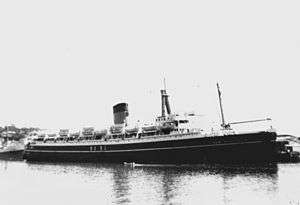SS New Australia
SS New Australia (also named Monarch of Bermuda and Arkadia) was a passenger ship that operated during the mid 20th century.
 SS New Australia | |
| History | |
|---|---|
| Name: | Monarch of Bermuda |
| Owner: | Furness Bermuda Line |
| Builder: | Vickers-Armstrong Shipbuilders |
| Launched: | 17 March 1931 |
| In service: | 1931 |
| Fate: | Sold 1947 |
| History | |
| Name: | New Australia |
| Owner: | British government |
| Operator: | Shaw Savill Line |
| Acquired: | 1947 |
| Fate: | Sold 1958 |
| History | |
| Name: | Arkadia |
| Owner: | Greek Line |
| Acquired: | 1958 |
| Fate: | Scrapped 1966 |
| General characteristics | |
| Tonnage: | 20,256 gross register tons |
| Length: | 579 ft (176 m) |
| Beam: | 76 ft (23 m) |
| Propulsion: | Steam turbines |
| Capacity: | 1,600 passengers (830 as built) |
She was built by Vickers-Armstrong Shipbuilders as Monarch of Bermuda for the Furness Bermuda Line, entering service in November 1931 and operating between New York City and Bermuda during the 1930s.[1] Her nearly identical sister ship was the SS Queen of Bermuda.[2] In 1939, she was transferred to military service as a troopship during and after World War II.[1]
In March 1947, while she was being refitted for resuming commercial service, she caught fire and Furness Bermuda sold her to the British government, which renamed her New Australia and repaired her for service transporting British immigrants to Australia.[1] Operated for the government by Shaw Savill Line, she served on the Australia run from 1950 until 1957.[1]
She was sold early 1958 to the Greek Line, which refitted her for commercial service and renamed her Arkadia.[1] In this configuration, she operated both transatlantic line service to Canada and cruises for most of the 1960s before being scrapped in Spain in 1966.[1]
The New Australia measured 20,256 gross register tons, and was 579 feet (176 m) long, with a beam of 76 feet (23 m).[1] She was powered by steam turbines, which drove four screws, giving her a service speed of 19.5 knots (22.4 mph).[1] She had a capacity of 1,600 passengers while in immigrant service, though as constructed she had room for 830 people in luxury accommodations.[1]
References
- Miller Jr., William (2001). Picture History of British Ocean Liners 1900 to the Present. Mineola, NY: Dover Publications. p. 87. ISBN 0-486-41532-5.
- Hardy, A. C. (8 September 1936). "Bermudian Luxury Liners". Shipping Wonders of the World (Part 31): 970–974. Retrieved 13 May 2020.